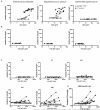Innate and adaptive immunity cooperate flexibly to maintain host-microbiota mutualism
- PMID: 19644121
- PMCID: PMC3730530
- DOI: 10.1126/science.1172747
Innate and adaptive immunity cooperate flexibly to maintain host-microbiota mutualism
Abstract
Commensal bacteria in the lower intestine of mammals are 10 times as numerous as the body's cells. We investigated the relative importance of different immune mechanisms in limiting the spread of the intestinal microbiota. Here, we reveal a flexible continuum between innate and adaptive immune function in containing commensal microbes. Mice deficient in critical innate immune functions such as Toll-like receptor signaling or oxidative burst production spontaneously produce high-titer serum antibodies against their commensal microbiota. These antibody responses are functionally essential to maintain host-commensal mutualism in vivo in the face of innate immune deficiency. Spontaneous hyper-activation of adaptive immunity against the intestinal microbiota, secondary to innate immune deficiency, may clarify the underlying mechanisms of inflammatory diseases where immune dysfunction is implicated.
Figures




Similar articles
-
The Probiotic Compound VSL#3 Modulates Mucosal, Peripheral, and Systemic Immunity Following Murine Broad-Spectrum Antibiotic Treatment.Front Cell Infect Microbiol. 2017 May 5;7:167. doi: 10.3389/fcimb.2017.00167. eCollection 2017. Front Cell Infect Microbiol. 2017. PMID: 28529928 Free PMC article.
-
Innate lymphoid cells regulate CD4+ T-cell responses to intestinal commensal bacteria.Nature. 2013 Jun 6;498(7452):113-7. doi: 10.1038/nature12240. Epub 2013 May 22. Nature. 2013. PMID: 23698371 Free PMC article.
-
Reversible microbial colonization of germ-free mice reveals the dynamics of IgA immune responses.Science. 2010 Jun 25;328(5986):1705-9. doi: 10.1126/science.1188454. Science. 2010. PMID: 20576892 Free PMC article.
-
The biology of intestinal immunoglobulin A responses.Immunity. 2008 Jun;28(6):740-50. doi: 10.1016/j.immuni.2008.05.001. Immunity. 2008. PMID: 18549797 Free PMC article. Review.
-
Role of the innate immune system and host-commensal mutualism.Curr Top Microbiol Immunol. 2006;308:1-18. doi: 10.1007/3-540-30657-9_1. Curr Top Microbiol Immunol. 2006. PMID: 16922084 Review.
Cited by
-
Alterations in the gut microbiota community are associated with childhood obesity and precocious puberty.BMC Microbiol. 2024 Aug 24;24(1):311. doi: 10.1186/s12866-024-03461-8. BMC Microbiol. 2024. PMID: 39182062 Free PMC article.
-
CD71 + erythroid cells promote intestinal symbiotic microbial communities in pregnancy and neonatal period.Microbiome. 2024 Jul 30;12(1):142. doi: 10.1186/s40168-024-01859-0. Microbiome. 2024. PMID: 39080725 Free PMC article.
-
The gut microbiome in disorders of gut-brain interaction.Gut Microbes. 2024 Jan-Dec;16(1):2360233. doi: 10.1080/19490976.2024.2360233. Epub 2024 Jul 1. Gut Microbes. 2024. PMID: 38949979 Free PMC article. Review.
-
Advances in molecular mechanisms of inflammatory bowel disease‑associated colorectal cancer (Review).Oncol Lett. 2024 Apr 9;27(6):257. doi: 10.3892/ol.2024.14390. eCollection 2024 Jun. Oncol Lett. 2024. PMID: 38646499 Free PMC article. Review.
-
Intergenerational protective anti-gut commensal immunoglobulin G originates in early life.Proc Natl Acad Sci U S A. 2024 Mar 26;121(13):e2309994121. doi: 10.1073/pnas.2309994121. Epub 2024 Mar 22. Proc Natl Acad Sci U S A. 2024. PMID: 38517976 Free PMC article.
References
Publication types
MeSH terms
Substances
Grants and funding
LinkOut - more resources
Full Text Sources
Other Literature Sources
Molecular Biology Databases

